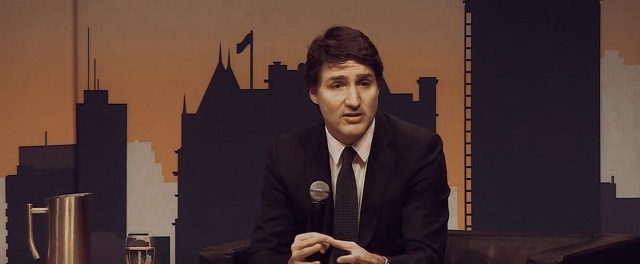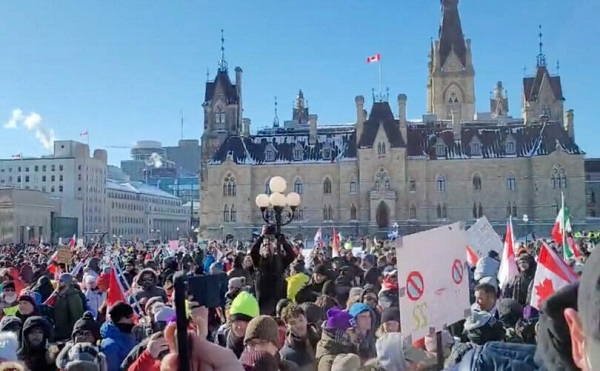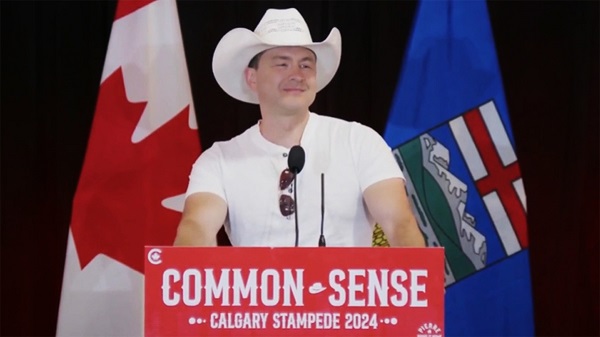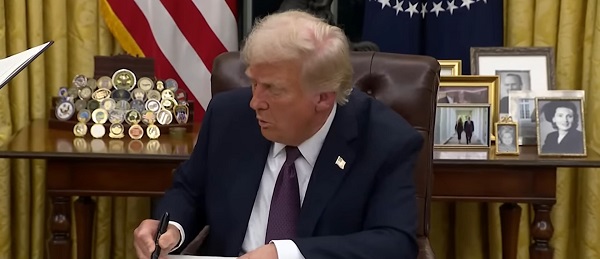Opinion
Trudeau’s Winnipeg Whitewash – A Masterclass in Diversion and Disconnection

From The Opposition with Dan Knight
As Canada grapples with soaring housing costs and a quality of life crisis, the Prime Minister’s narrative on immigration & multicultural success stories clashes with the lived realities of Canadians
As some of you enjoyed the comfort of Family Day, perhaps some of you noticed Justin Trudeau making the rounds in Winnipeg – (Justin Trudeau Fireside Chat at Winnipeg Chamber of Commerce – February 16, 2024), where he found quite the fan in Loren Remillard of the Winnipeg Chamber of Commerce. It seems Remillard was all too eager to extend a metaphorical hand, fishing for tax dollars to prop up their projects.
Oh, let’s dissect the masterful art of political deflection and diversion, shall we? Justin Trudeau, spun a narrative so disconnected from the reality Canadians live in, it’s almost an art form. He lauds Toronto and Vancouver as paragons of multicultural success, cities thriving under the weight of their diversity. But here’s the catch folks—the reality on the ground, as reported by Stats Canada, tells a story that’s anything but rosy for the residents of these supposed utopias.
When we turn our gaze to the real impact of his government’s immigration policies on the ground, the picture is starkly different. Toronto and Vancouver, the benchmarks of Trudeau’s immigration success story, are in fact cities where residents report a lower quality of life than their provincial counterparts. Why? Because amidst the fanfare of diversity and inclusion, the basic needs of the citizens—like feeling a sense of belonging, life satisfaction, and mental health—are being sidelined.
Let’s not forget the elephant in the room Trudeau casually mentioned—2 million temporary residents flooding into Canada. This isn’t just a number; it’s a tsunami of demand in addition to the Liberal 500k target per year of permanent resident hitting a housing market already gasping for air, driving rents and shelter costs to astronomical heights. And Trudeau’s response? A shrug of the shoulders and a diversion to talk about measures with Mexico or the plight of international students. While these issues merit attention, they dance around the core issue: a government more obsessed with its global image than the welfare of its citizens.
The audacity to claim that Toronto and Vancouver are thriving under his policies, while Stats Canada directly contradicts this with evidence of declining quality of life, is nothing short of political theater. It’s a sleight of hand designed to distract from the harsh reality—that his government’s approach to immigration and temporary residents is contributing to a crisis of affordability and well-being in our major cities.
But amidst the spectacle, Trudeau touched on a subject that should raise eyebrows across the nation: On how his government is using immigration as a tool to “grow the economy.” Now, let’s pause for a moment to digest that, shall we?
Diving deeper, a fascinating exchange caught my ear during a Finance Committee meeting FINA-124 -February 1, 2024, where Tiff Macklem of the Bank of Canada offered some candid insights. When prodded by Mr. Jasraj Singh Hallan, Macklem conceded that the government’s spending spree and the Bank’s efforts to stabilize our economy were essentially at loggerheads. Here we have the Trudeau administration, pushing fiscal policies that seem to sprint in the opposite direction of monetary sanity.
Macklem went on, outlining that yes, government spending is contributing to growth, but let’s be clear about the kind of growth we’re talking about here. It’s one that barely keeps pace with population increases, teetering on the edge of potential. And with government spending poised to climb even higher, we’re flirting dangerously close to exacerbating inflation, rather than reining it in.
Senior Deputy Governor Carolyn Rogers chimed in with a stark reminder of the housing market’s woes. Despite interest rate hikes, which traditionally cool down housing prices, Canada’s chronic housing shortage keeps prices stubbornly high. The result? A housing affordability crisis that’s squeezing Canadians tighter than ever, exacerbated by an immigration policy that is throwing fuel on the fire of demand without addressing the urgent need for supply.
This is the picture Trudeau’s policies paint for Canada: a nation where the cost of living climbs ever higher, where the dream of homeownership slips further away for the average citizen, and where economic growth strategies seem disconnected from the realities on the ground. It’s high time for a reality check, a moment to ask ourselves whether these policies truly serve the best interest of Canadians or merely the political agenda of those in power.
Indeed, the root of the issue is staring us right in the face—supply problems are driving costs through the roof. Yet, it seems as though there’s a conspiracy of silence in the House of Commons; no one dares to utter the truth that unchecked immigration is exacerbating these supply woes, sending shelter costs soaring. Let’s dive into the latest from Stats Canada to unravel the narrative everyone is thriving under Justin Trudeau.
First off, let’s talk about renters. According to this report, if you’re renting, your quality of life isn’t just on the lower rung; it’s plummeting. Renters are staggering under the weight of financial pressures unheard of for homeowners, feeling the pinch of record-low vacancy rates and rent hikes that would make your head spin. Over 15 percentage points more likely to struggle financially and over 11 points less likely to experience life satisfaction.
But the plot thickens when we look at the younger Canadians, those aged 15 to 54. They’re caught in a vise, with life satisfaction and mental health scores that trail behind their older counterparts. The dream of home ownership? A mirage for many, as they navigate a landscape where the very idea of paying off a mortgage seems like a relic of a bygone era. And let’s not even get started on the economic tightrope walked by residents of Toronto and Vancouver, cities where the cost of living soars as high as the skyscrapers dotting their skylines.
Now, Trudeau’s government might have you believe that policies are in place to bridge these divides, to bolster the quality of life for all Canadians. But let’s be real—the evidence suggests otherwise. With renters and younger generations buckling under financial strains and cities like Toronto and Vancouver becoming enclaves of the unaffordable, the narrative being spun by the current administration seems more fiction than fact.
Consider the financial strain laid bare by these statistics: a significant portion of Canadians are finding it increasingly difficult to meet their financial needs, with shelter costs consuming a lion’s share of their income.
In a landscape marked by disparities in quality of life we’re left with a pressing question: where does the path forward lie?
Let’s cut to the chase, folks. The latest 338 polling data isn’t just a blip on the political radar; it’s a resounding bell tolling for the end of the Liberals’ reign, inching closer to losing their official party status. Why, you might ask? It’s simple: Justin Trudeau’s legacy is one of profound ineptitude, a legacy that has systematically failed Canadians at every turn. When Trudeau touts his housing policies, claiming to increase rentals, remember the cold, hard facts from Stats Canada—he’s not building homes; he’s crafting a nation with a diminished quality of life. That’s the Trudeau vision for Canada.
And let’s not overlook the audacity of his actions—jetting off to Jamaica with a hefty $162,000 bill footed by you, the taxpayer. It seems Trudeau’s concern for your quality of life evaporates faster than a Liberal MP can devour lobster in Malaysia. Meanwhile, ordinary Canadians are left to scrounge at food banks. But hey, as long as the political elite get their fill, right?
SNC-Lavalin was just the beginning, the canary in the coal mine signaling the avalanche of corruption set to spill out from Trudeau’s government. WE Charity, the Trudeau Foundation, Chinese interference, ArriveScam… the list of scandals under Trudeau’s watch is as long as it is disgraceful. These aren’t mere footnotes in history; they’re the defining features of his tenure.
Remember the uproar over a $16 orange juice under Harper? That was considered the height of scandal, a benchmark of accountability. Fast forward to today, and this government can’t even spell ‘ethics,’ let alone practice it.
So, my fellow Canadians, as we look ahead to the next election, we’re presented with a golden opportunity—a chance to reset the narrative and send a clear message to the liberal elites that we’ve had enough of their disdain for the average citizen. I, for one, will be cheering on the red wedding of Canadian politics because the liberal standard is not just detrimental to your well-being; it’s an affront to all of Canada. It’s time to say enough is enough and reclaim the Canada we know and love—a Canada of integrity, accountability, and true north strong and free.
Freedom Convoy
Court Orders Bank Freezing Records in Freedom Convoy Case

|
A Canadian court has ordered the release of documents that could shed light on how federal authorities and law enforcement worked together to freeze the bank accounts of a protester involved in the Freedom Convoy.
Both the RCMP and TD Bank are now required to provide records related to Evan Blackman, who took part in the 2022 demonstrations and had his accounts frozen despite not being convicted of any crime at the time.
The Justice Centre for Constitutional Freedoms (JCCF) announced the Ontario Court of Justice ruling. The organization is representing Blackman, whose legal team argues that the actions taken against him amounted to a serious abuse of power.
“The freezing of Mr. Blackman’s bank accounts was an extreme overreach on the part of the police and the federal government,” said his lawyer, Chris Fleury. “These records will hopefully reveal exactly how and why Mr. Blackman’s accounts [were] frozen.”
Blackman was arrested during the mass protests in Ottawa, which drew thousands of Canadians opposed to vaccine mandates and other pandemic-era restrictions.
Although he faced charges of mischief and obstructing police, those charges were dismissed in October due to a lack of evidence. Despite this, prosecutors have appealed, and a trial is set to begin on August 14.
At the height of the protests, TD Bank froze three of Blackman’s accounts following government orders issued under the Emergencies Act. Then-Prime Minister Justin Trudeau had invoked the act to grant his government broad powers to disrupt the protest movement, including the unprecedented use of financial institutions to penalize individuals for their support or participation.
In 2024, a Federal Court Justice ruled that Trudeau’s decision to invoke the act had not been justified.
Blackman’s legal team plans to use the newly released records to demonstrate the extent of government intrusion into personal freedoms.
According to the JCCF, this case may be the first in Canada where a criminal trial includes a Charter challenge over the freezing of personal bank accounts under emergency legislation.
|
Alberta
‘Far too serious for such uninformed, careless journalism’: Complaint filed against Globe and Mail article challenging Alberta’s gender surgery law

Macdonald Laurier Institute challenges Globe article on gender medicine
The complaint, now endorsed by 41 physicians, was filed in response to an article about Alberta’s law restricting gender surgery and hormones for minors.
On June 9, the Macdonald-Laurier Institute submitted a formal complaint to The Globe and Mail regarding its May 29 Morning Update by Danielle Groen, which reported on the Canadian Medical Association’s legal challenge to Alberta’s Bill 26.
Written by MLI Senior Fellow Mia Hughes and signed by 34 Canadian medical professionals at the time of submission to the Globe, the complaint stated that the Morning Update was misleading, ideologically slanted, and in violation the Globe’s own editorial standards of accuracy, fairness, and balance. It objected to the article’s repetition of discredited claims—that puberty blockers are reversible, that they “buy time to think,” and that denying access could lead to suicide—all assertions that have been thoroughly debunked in recent years.
Given the article’s reliance on the World Professional Association for Transgender Health (WPATH), the complaint detailed the collapse of WPATH’s credibility, citing unsealed discovery documents from an Alabama court case and the Cass Review’s conclusion that WPATH’s guidelines—and those based on them—lack developmental rigour. It also noted the newsletter’s failure to mention the growing international shift away from paediatric medical transition in countries such as the UK, Sweden, and Finland. MLI called for the article to be corrected and urged the Globe to uphold its commitment to balanced, evidence-based journalism on this critical issue.
On June 18, Globe and Mail Standards Editor Sandra Martin responded, defending the article as a brief summary that provided a variety of links to offer further context. However, the three Globe and Mail news stories linked to in the article likewise lacked the necessary balance and context. Martin also pointed to a Canadian Paediatric Society (CPS) statement linked to in the newsletter. She argued it provided “sufficient context and qualification”—despite the fact that the CPS itself relies on WPATH’s discredited guidelines. Notwithstanding, Martin claimed the article met editorial standards and that brevity justified the lack of balance.
MLI responded that brevity does not excuse misinformation, particularly on a matter as serious as paediatric medical care, and reiterated the need for the Globe to address the scientific inaccuracies directly. MLI again called for the article to be corrected and for the unsupported suicide claim to be removed. As of this writing, the Globe has not responded.
Letter of complaint
June 9, 2025
To: The Globe and Mail
Attn: Sandra Martin, standards editor
CC: Caroline Alphonso, health editor; Mark Iype, deputy national editor and Alberta bureau chief
To the editors;
Your May 29 Morning Update: The Politics of Care by Danielle Groen, covering the Canadian Medical Association’s legal challenge to Alberta’s Bill 26, was misleading and ideologically slanted. It is journalistically irresponsible to report on contested medical claims as undisputed fact.
This issue is far too serious for such uninformed, careless journalism lacking vital perspectives and scientific context. At stake is the health and future of vulnerable children, and your reporting risks misleading parents into consenting to irreversible interventions based on misinformation.
According to The Globe and Mail’s own Journalistic Principles outlined in its Editorial Code of Conduct, the credibility of your reporting rests on “solid research, clear, intelligent writing, and maintaining a reputation for honesty, accuracy, fairness, balance and transparency.” Moreover, your principles go on to state that The Globe will “seek to provide reasonable accounts of competing views in any controversy.” The May 29 update violated these principles. There is, as I will show, a widely available body of scientific information that directly contests the claims and perspectives presented in your article. Yet this information is completely absent from your reporting.
The collapse of WPATH’s credibility
The article’s claim that Alberta’s law “falls well outside established medical practice” and could pose the “greatest threat” to transgender youth is both false and inflammatory. There is no global medical consensus on how to treat gender-distressed young people. In fact, in North America, guidelines are based on the Standards of Care developed by the World Professional Association for Transgender Health (WPATH)—an organization now indisputably shown to place ideology above evidence.
For example, in a U.S. legal case over Alabama’s youth transition ban, WPATH was forced to disclose over two million internal emails. These revealed the organization commissioned independent evidence reviews for its latest Standards of Care (SOC8)—then suppressed those reviews when they found overwhelmingly low-quality evidence. Yet WPATH proceeded to publish the SOC8 as if it were evidence-based. This is not science. It is fraudulent and unethical conduct.
These emails also showed Admiral Rachel Levine—then-assistant secretary for Health in the Biden administration—pressured WPATH to remove all lower age recommendations from the guidelines—not on scientific grounds, but to avoid undermining ongoing legal cases at the state level. This is politics, not sound medical practice.
The U.K.’s Cass Review, a major multi-year investigation, included a systematic review of the guidelines in gender medicine. A systematic review is considered the gold standard because it assesses and synthesizes all the available research in a field, thereby reducing bias and providing a large comprehensive set of data upon which to reach findings. The systematic review of gender medicine guidelines concluded that WPATH’s standards of care “lack developmental rigour” and should not be used as a basis for clinical practice. The Cass Review also exposed citation laundering where medical associations endlessly recycled weak evidence across interlocking guidelines to fabricate a false consensus. This led Cass to suggest that “the circularity of this approach may explain why there has been an apparent consensus on key areas of practice despite the evidence being poor.”
Countries like Sweden, Finland, and the U.K. have now abandoned WPATH and limited or halted medicalized youth transitions in favour of a therapy-first approach. In Norway, UKOM, an independent government health agency, has made similar recommendations. This shows the direction of global practice is moving away from WPATH’s medicalized approach—not toward it. As part of any serious effort to “provide reasonable accounts of competing views,” your reporting should acknowledge these developments.
Any journalist who cites WPATH as a credible authority on paediatric gender medicine—especially in the absence of contextualizing or competing views—signals a lack of due diligence and a fundamental misunderstanding of the field. It demonstrates that either no independent research was undertaken, or it was ignored despite your editorial standards.
Puberty blockers don’t ‘buy time’ and are not reversible
Your article repeats a widely debunked claim: that puberty blockers are a harmless pause to allow young people time to explore their identity. In fact, studies have consistently shown that between 98 per cent and 100 per cent of children placed on puberty blockers go on to take cross-sex hormones. Before puberty blockers, most children desisted and reconciled with their birth sex during or after puberty. Now, virtually none do.
This strongly suggests that blocking puberty in fact prevents the natural resolution of gender distress. Therefore, the most accurate and up-to-date understanding is that puberty blockers function not as a pause, but as the first step in a treatment continuum involving irreversible cross-sex hormones. Indeed, a 2022 paper found that while puberty suppression had been “justified by claims that it was reversible … these claims are increasingly implausible.” Again, adherence to the Globe’s own editorial guidelines would require, at minimum, the acknowledgement of the above findings alongside the claims your May 29 article makes.
Moreover, it is categorically false to describe puberty blockers as “completely reversible.” Besides locking youth into a pathway of further medicalization, puberty blockers pose serious physical risks: loss of bone density, impaired sexual development, stunted fertility, and psychosocial harm from being developmentally out of sync with peers. There are no long-term safety studies. These drugs are being prescribed to children despite glaring gaps in our understanding of their long-term effects.
Given the Globe’s stated editorial commitment to principles such as “accuracy,” the crucial information from the studies linked above should be provided in any article discussing puberty blockers. At a bare minimum, in adherence to the Globe’s commitment to “balance,” this information should be included alongside the contentious and disputed claims the article makes that these treatments are reversible.
No proof of suicide prevention
The most irresponsible and dangerous claim in your article is that denying access to puberty blockers could lead to “depression, self-harm and suicide.” There is no robust evidence supporting this transition-or-suicide narrative, and in fact, the findings of the highest-quality study conducted to date found no evidence that puberty suppression reduces suicide risk.
Suicide is complex and attributing it to a single cause is not only false—it violates all established suicide reporting guidelines. Sensationalized claims like this risk creating contagion effects and fuelling panic. In the public interest, reporting on the topic of suicide must be held to the most rigorous standards, and provide the most high-quality and accurate information.
Euphemism hides medical harm
Your use of euphemistic language obscures the extreme nature of the medical interventions being performed in gender clinics. Calling double mastectomies for teenage girls “paediatric breast surgeries for gender-affirming reasons” sanitizes the medically unnecessary removal of a child’s healthy organs. Referring to phalloplasty and vaginoplasty as “gender-affirming surgeries on lower body parts” conceals the fact that these are extreme operations involving permanent disfigurement, high complication rates, and often requiring multiple revisions.
Honest journalism should not hide these facts behind comforting language. Your reporting denies youth, their parents, and the general public the necessary information to understand the nature of these interventions. Members of the general public rely greatly on the news media to equip them with such information, and your own editorial standards claim you will fulfill this core responsibility.
Your responsibility to the public
As a flagship Canadian news outlet, your responsibility is not to amplify activist messaging, but to report the truth with integrity. On a subject as medically and ethically fraught as paediatric gender medicine, accuracy is not optional. The public depends on you to scrutinize claims, not echo ideology. Parents may make irreversible decisions on behalf of their children based on the narratives you promote. When reporting is false or ideologically distorted, the cost is measured in real-world harm to some of our society’s most vulnerable young people.
I encourage the Globe and Mail to publish an updated version on this article in order to correct the public record with the relevant information discussed above, and to modify your reporting practices on this matter going forward—by meeting your own journalistic standards—so that the public receives balanced, correct, and reliable information on this vital topic.
Trustworthy journalism is a cornerstone of public health—and on the issue of paediatric gender medicine, the stakes could not be higher.
Sincerely,
Mia Hughes
Senior Fellow, Macdonald-Laurier Institute
Author of The WPATH Files
The following 41 physicians have signed to endorse this letter:
Dr. Mike Ackermann, MD
Dr. Duncan Veasey, Psy MD
Dr. Rick Gibson, MD
Dr. Benjamin Turner, MD, FRCSC
Dr. J.N. Mahy, MD, FRCSC, FACS
Dr. Khai T. Phan, MD, CCFP
Dr. Martha Fulford, MD
Dr. J. Edward Les, MD, FRCPC
Dr. Darrell Palmer, MD, FRCPC
Dr. Jane Cassie, MD, FRCPC
Dr. David Lowen, MD, FCFP
Dr. Shawn Whatley, MD, FCFP (EM)
Dr. David Zitner, MD
Dr. Leonora Regenstreif, MD, CCFP(AM), FCFP
Dr. Gregory Chan, MD
Dr. Alanna Fitzpatrick, MD, FRCSC
Dr. Chris Millburn, MD, CCFP
Dr. Julie Curwin, MD, FRCPC
Dr. Roy Eappen, MD, MDCM, FRCP (c)
Dr. York N. Hsiang, MD, FRCSC
Dr. Dion Davidson, MD, FRCSC, FACS
Dr. Kevin Sclater, MD, CCFP (PC)
Dr. Theresa Szezepaniak, MB, ChB, DRCOG
Dr. Sofia Bayfield, MD, CCFP
Dr. Elizabeth Henry, MD, CCFP
Dr. Stephen Malthouse, MD
Dr. Darrell Hamm, MD, CCFP
Dr. Dale Classen, MD, FRCSC
Dr. Adam T. Gorner, MD, CCFP
Dr. Wesley B. Steed, MD
Dr. Timothy Ehmann, MD, FRCPC
Dr. Ryan Torrie, MD
Dr. Zachary Heinricks, MD, CCFP
Dr. Jessica Shintani, MD, CCFP
Dr. Mark D’Souza, MD, CCFP(EM), FCFP*
Dr. Joanne Sinai, MD, FRCPC*
Dr. Jane Batt, MD*
Dr. Brent McGrath, MD, FRCPC*
Dr. Leslie MacMillan MD FRCPC (emeritus)*
Dr. Ian Mitchell, MD, FRCPC*
Dr. John Cunnington, MD
*Indicates physician who signed following the letter’s June 9 submission to the Globe and Mail, but in advance of this letter being published on the MLI website.
-

 MAiD2 days ago
MAiD2 days agoCanada’s euthanasia regime is already killing the disabled. It’s about to get worse
-

 Daily Caller14 hours ago
Daily Caller14 hours agoUSAID Quietly Sent Thousands Of Viruses To Chinese Military-Linked Biolab
-

 Alberta11 hours ago
Alberta11 hours ago‘Far too serious for such uninformed, careless journalism’: Complaint filed against Globe and Mail article challenging Alberta’s gender surgery law
-

 Censorship Industrial Complex22 hours ago
Censorship Industrial Complex22 hours agoCanadian pro-freedom group sounds alarm over Liberal plans to revive internet censorship bill
-

 Fraser Institute1 day ago
Fraser Institute1 day agoBefore Trudeau average annual immigration was 617,800. Under Trudeau number skyrocketted to 1.4 million from 2016 to 2024
-

 Daily Caller2 days ago
Daily Caller2 days ago‘I Know How These People Operate’: Fmr CIA Officer Calls BS On FBI’s New Epstein Intel
-

 International2 days ago
International2 days agoChicago suburb purchases childhood home of Pope Leo XIV
-

 Economy1 day ago
Economy1 day agoThe stars are aligning for a new pipeline to the West Coast




